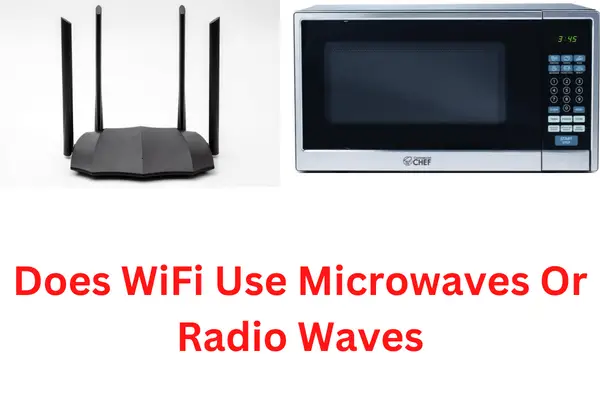Your internet wireless fidelity connection transmits signals using radio waves or microwaves. When you connect your device to the Wi-Fi router system, you get the signals via the radio waves. There are two radio waves that WiFi can utilize. These are the 5 gigahertz (GHz) and 2.4 gigahertz (GHz).
WiFi uses radio waves to transmit data. These radio waves are part of the electromagnetic spectrum and operate primarily on 2.4 and 5 GHz frequencies. While technically, microwaves are a form of radio waves with frequencies ranging from about 1 GHz to 300 GHz, the term “microwaves” specifically refers to the higher frequency part of this range. WiFi signals, operating in the 2.4 GHz and 5 GHz bands, fall within the microwave category by frequency, but in common usage, WiFi is said to utilize radio waves for communication.
Don’t worry about the terminologies. We will make it easier for you. That way, you understand various device functionalities in your home.
Do Microwaves Interfere With Radio Waves?
Both microwaves and radio waves are electromagnetic waves. They are radiative and work in frequencies per second. Suppose you keep two devices radiating two different waves (microwaves and radio waves). There will be interference. Microwave radiation is stronger than radio waves because they have high photons.
So, yes, interference will occur. Operating your microwave oven will interfere with your WiFi connection if it uses radio waves. You will begin experiencing poor internet connectivity on your smart devices. The reason is a clash of frequencies or waves.
Try using your internet-enabled laptop or iPad near your microwave oven and observe the connectivity. Google photos and other web pages will struggle to download.
That tells you the electromagnetic radiations from the electrical signals of the microwave oven hinder WiFi functionality. At home, your Wi-Fi signals use radio waves, so your devices also try to pick them up when the microwaves are radiating.
Why Are Microwaves Better Than Radio Waves?
As we mentioned earlier, both microwaves and radiowaves are electromagnetic. But one is stronger than the other. Microwaves have higher photons than radio waves. So they are more robust.
The microwaves are strong enough to heat food, hence the science behind the microwave oven on your countertop. It would take days to hear your food with radio waves!
Scientifically, we cannot say microwaves are better than radio waves unless we compare device performance. Each radiation is unique to its purpose. For example, you wouldn’t use radiowaves for cooking your food.
Conversely, you cannot use microwaves widely for radio transmissions, only for communicating with satellites. The reason is microwaves have a small wavelength and are, therefore, great for point-to-point networks. The wavelength only works with unique antennas to connect them in narrow beams.
With radio waves, we receive radio signals from a far distance. Also, the waves do not require much energy to radiate. Microwaves will need more power to convert to longer-wavelength cook food.
On the bottom line, microwaves are better for cooking and short-length communication. The radiowaves are also better for long-distance WiFi signals and radio networks. None can substitute for the other.
To capture the differences between these two waves, we have a chart here.
Radio waves vs. Microwaves chart:
| Comparison | Radio waves | Microwaves |
| Energy | Low | High |
| Wavelength | Greater than 1.0 m | Between 0.1 – 1 mm |
| Frequency | Low | High |
| Detection | Ariel | Diode point contact |
| Generation | Electron rapid acceleration/deceleration in aerials. | Magnetron/Klystron |
| Travel direction | Omnidirectional | Unidirectional |
| Application | Bluetooth, Radio FM/AM, TV, Cell phone | Microwave, Radar, aerospace, navigation |
Does Radar Use Microwaves Or Radio Waves?
Radars function like mobile phones and other smart wireless devices. The gadgets use electromagnetic waves that are similar to wireless computer networks.
These signals radiate as short pulses and target objects in their path. Then, they reflect the Radar. Radars are essential for tracking space. They can penetrate through clouds at considerable distances.
The gadgets use microwaves, an advanced technology, to sense and send pulses remotely. The sensing instruments thus use microwave frequencies and other technology to detect objects and gather information.
Does Bluetooth Use Radio Waves Or Microwaves?
If you wanted to transfer large files to another device within proximity, you would prefer Bluetooth. Also, you will not require the internet. You are set to go as long as the Bluetooth can connect to the other device.
What’s the technology behind this data transfer? Is it radio waves or microwaves? Bluetooth uses radiowaves and not microwaves. The radio wave is in the form of ultra-high frequency (UHF).
Like microwaves, these waves are also electromagnetic. Their frequency is about 2.4 gigahertz. UHF waves have different frequencies than microwave ovens and radar devices.
Unfortunately, your Bluetooth devices will have issues if you operate them near a microwave. The reason is they, too, connect to any electromagnetic waves. They will pick the microwaves and cause a frequency clash. So use your Bluetooth devices away from your running microwave.

